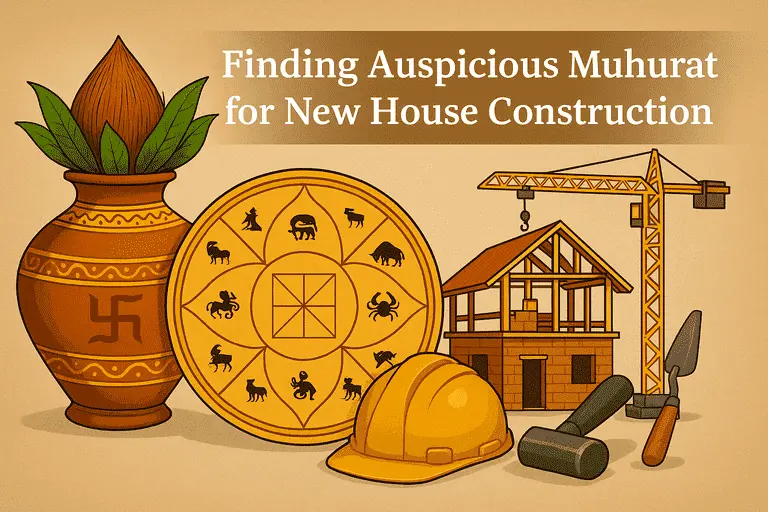Bhumi Pujan & Shilanyas – The Sacred Beginning of Construction
“Before laying the first stone, awaken the soul of the land.”
Why Muhurat Matters
Every piece of land is alive with Pancha Mahabhuta — Earth, Water, Fire, Air, and Space.
Choosing the right muhurat (auspicious time) aligns your structure with cosmic motion, ensuring strength, prosperity, and spiritual harmony.
According to Raj Vallabh & Surya Siddhanta, the exact relationship of Sun & Moon decides when the Earth’s energy is most balanced for new construction.
1. Auspicious Tithis for Starting Construction
शुभा तिथयः – द्वितीया तृतीया पञ्चमी सप्तमी दशमी एकादशी त्रयोदशी पूर्णिमा।
Shubhā tithayaḥ – Dvitīyā, Tṛtīyā, Pañcamī, Saptamī, Daśamī, Ekādaśī, Trayodaśī, Pūrṇimā.
Meaning: These tithis invite stability, wealth, and divine grace.
| ✅ Favourable Tithis | ⚠️ Avoid Tithis |
|---|---|
| Dwitiya (2nd) | Amavasya (New Moon) |
| Tritiya (3rd) | Chaturthi (4th) |
| Panchami (5th) | Ashtami (8th) |
| Saptami (7th) | Chaturdashi (14th) |
| Dashami (10th) | |
| Ekadashi (11th) | |
| Trayodashi (13th) | |
| Purnima (Full Moon) |
✨ Tip: Begin foundation work on a waxing-Moon day after sunrise.
Waxing (Shukla Paksha – Increasing Moon):
The waxing phase begins right after Amavasya (New Moon) when the Moon starts becoming visible and gradually grows brighter each night. This period continues until Purnima (Full Moon), when the Moon is completely illuminated.
Example: Waxing Crescent – the growing crescent moon seen after Amavasya.
Waning (Krishna Paksha – Decreasing Moon):
The waning phase begins right after Purnima (Full Moon) when the Moon slowly moves toward darkness. During this period, the visible portion of the Moon decreases each night until it becomes completely dark again on Amavasya (New Moon).
Example: Waning Crescent – the shrinking crescent moon seen before Amavasya.
2. Favourable Nakshatras for Shilanyas
स्थिरा रोहिणी मृगशिरा उत्तरा फाल्गुनी च उत्तराषाढा उत्तरभाद्रपदा च।
Sthirā Rohiṇī Mṛgaśirā Uttarā Phālgunī Uttarāṣāḍhā Uttarabhādrapadā cha.
Meaning: Fixed stars bring firmness and endurance to every wall you raise.
Core rules
- Nature of work vs. nature of star
- Permanent/structural works → Sthira (fixed) nakshatras (they “hold” and “last”).
- Domestic, harmonious works → Mridu (gentle) can also suit homes (comfort, cohesion).
- Travel/transactions/change → Chara (moveable) (not ideal for foundations).
- Surgery, conflicts, breaking → Ugra/Tīkṣṇa (avoid for building).
- Deity & Shakti (power)
- Deities linked to sustaining order, patronage, undefeatable success, foundations, protection support construction.
- Shaktis like “permanent victory,” “patronage/contract,” “stability,” “nourishment,” “shelter” align with building.
- Symbolism & outcomes
- Symbols such as yoke/bed/post (support), twins of the latter half (completion/continuity), serpent of depths (foundations), chariot drum (order) point to longevity and robustness.
| Nakshatra | Nature | Deity / Shakti (essence) | Why good for construction |
|---|---|---|---|
| Rohini | Sthira (fixed) | Brahma / growth & creation | Fertility, steady growth, material prosperity → buildings “take root” and flourish. |
| Mrigashira (Mrugasira) | Mridu (gentle) | Soma / seeking, gentle expansion | Harmonious households; encourages calm, incremental development rather than upheaval. |
| Uttara Phalguni (Uttara) | Sthira | Aryaman / patronage, contracts | Excellent for long-term commitments, legal/contractual stability, structural endurance. |
| Uttara Ashadha (Uttara-Shaada) | Sthira | Vishvadevas / undefeatable victory | “That which cannot be defeated” → permanence, reputation, and sturdy results. |
| Uttara Bhadrapada (Uttara-Bhadra) | Sthira | Ahirbudhnya / depth, foundations | “Support from below” archetype—great for footings, piles, underground stability. |
| Hasta | Mridu | Savitar / craft, hands, skill | Precision, workmanship, finishing quality—good when build quality is paramount. |
| Anuradha | Mixed-friendly | Mitra / cooperation, order | Strong for coordination of teams, compliance, and stepwise execution. |
| Revati (Revathi) | Mridu/Prosperous | Pushan / nourishment, safe journeys | Protects assets; auspicious closure and smooth occupancy later. |
| Shravana (Sravanam) | Sthira-leaning | Vishnu / order, architecture of space | Favors planning, compliance, institutional buildings, and community order. |
| Swati | Chara-airy but benefic | Vayu / self-sufficiency, refinement | Useful for industrial/innovative builds; needs balancing (wind/light frameworks). |
🚫 Avoid Krittika, Magha, Moola, Purvashadha, Purvabhadrapada, and Ardra Nakshatras.
3. Weekdays (Vāra)
सोम बुध गुरु शुक्र दिवसाः शुभाः। रवि मङ्गल शनिवारे निषिद्धाः।
Soma, Budha, Guru, Shukra divasāḥ shubhāḥ; Ravi, Maṅgala, Shanivāre niṣiddhāḥ.
Meaning: Build in harmony with calm and prosperity, not haste or conflict.
| 🌈 Favourable Days | 🚫 Avoid Days |
|---|---|
| Monday (Somavar) – peace & healing | Sunday – weak Sun energy |
| Wednesday (Budhvar) – clarity & planning | Tuesday – Mars causes accidents |
| Thursday (Guruvar) – wisdom & growth | Saturday – delays & obstacles |
| Friday (Shukravar) – beauty & prosperity |
4. Directional & Planetary Guidelines
- Perform Bhumi Pujan facing East or North.
- Start excavation from North-East (Ishanya) → extend towards South-West (Nairitya).
- Ensure Jupiter & Venus are strong, and Moon is waxing.
- Avoid malefic aspects from Saturn, Rahu, Ketu on the Lagna.
Why Jupiter, Venus, and Moon Matter in Vaastu & Construction
| Planet | Symbolic Domain | Effect on Building |
|---|---|---|
| Jupiter (Guru) | Expansion, wisdom, growth, protection | Gives moral & financial stability; ensures occupants prosper |
| Venus (Shukra) | Design, aesthetics, comfort, harmony | Ensures beauty, amenities, and pleasure in living |
| Moon (Chandra) | Water, nourishment, mental peace | Determines emotional energy, well-being of residents |
If all three are strong → the Devas of prosperity and peace align with your foundation.
If any are weak or afflicted → energy manifests as delay, loss, or discomfort.
A. Check if Moon is Waxing
If the date is between Amavasya (New Moon) and Purnima (Full Moon) → Waxing (Shukla Paksha)
B. Check Strength of Jupiter & Venus
Step-by-step:
Get planetary longitudes for the given date/time/location.
Determine Rashi & dignity of Jupiter and Venus.
Jupiter strong if: own sign (Sagittarius/Pisces) or exaltation (Cancer) or friendly sign.
Venus strong if: own sign (Taurus/Libra) or exaltation (Pisces).
Weak if: debilitation (Capricorn for Jupiter, Virgo for Venus) or combust (within ~8° of Sun).
Optional refinement – check if they are angular (Kendra) or trinal (Trikona) from Lagna.
1st, 4th, 7th, 10th (Kendra) or 1st, 5th, 9th (Trikona) = very auspicious.
C. Avoid Malefic Aspects on Lagna
You need the event chart (Janma Lagna for the muhurta).
Compute the Lagna sign using the astrology free tools.
Lagna changes every ~2 hours, so choose precise muhurta time.
Check aspect (drishti) from malefics:
Saturn aspects 3rd, 7th, 10th houses from itself.
Rahu & Ketu aspect the 5th and 9th from themselves (in some traditions, also 7th).
If any of these fall on Lagna, it’s afflicted.
5. Seasonal Preference
उत्तरायणं शुभं कर्मणां प्रारम्भाय।
Uttarāyaṇaṁ shubhaṁ karmaṇāṁ prārambhāya.
Meaning: When the Sun moves northward, creation thrives.
- Uttarayan ( Jan – Jul ) → Ideal for construction
- Dakshinayan ( Jul – Dec ) → Avoid initiation
Period Typical Meaning Construction Launch Status Uttarāyaṇa North-ward Sun, longer days, “day of gods” Highly favourable for big, lasting works Dakṣiṇāyaṇa South-ward Sun, shorter days, “night of gods” Less favourable for new foundational start; ok with strong compensations
Why Uttarāyaṇa is Preferred
- Sun’s Northward Journey (“Rise” of Light)
- Uttarāyaṇa means “north-ward movement” of the Sun.
- Days become longer than nights in many parts of India, symbolising growth, expansion, progress.
- Scripturally, Uttarāyaṇa is called the “day of the gods,” whereas Dakṣiṇāyaṇa is their “night.”
- Positive Symbolism for Beginnings
- Since it signals light increasing, good fortune, harvest season, it is naturally aligned with initiation of enduring works (houses, foundations, long-term commitments).
- Many festival traditions tie happy beginnings to this period.
Traditional Muḥūrta Logic
- Building/construction is a “foundation” act; you want conditions aligned for sustainability, growth, and outward expansion → Uttarāyaṇa fits.
- In contrast, during Dakṣiṇāyaṇa, the trend is more inward, contraction, less daylight, thus less ideal for launching big outward projects.
6. Ritual Sequence for Bhumi Pujan
① Land Cleansing (Bhumi Shuddhi)
ॐ भूर्भुवः स्वः भूमिदेवतायै नमः।
Om Bhur Bhuvaḥ Swaḥ, Bhūmi Devatāyai Namah
Meaning: I bow to Mother Earth, the sustainer of all life.
Sprinkle Ganga water & cow urine to purify the site.
② Vastu Purusha Avahan (Invocation)
वास्तुपुरुषाय नमः। सर्वदोष निवारणार्थं स्थापयामि।
Vāstu Purushāya Namah, Sarva-doṣa-nivāraṇārthaṁ sthāpayāmi.
Meaning: I invoke the cosmic being of space to remove all defects.
Draw the Vastu Purusha Mandala (81-pad square) on the ground.
③ Shilaanyaas (Foundation Laying)
ॐ नमो वास्तुपुरुषाय, भूमेः स्थैर्यं भवतु।
Om Namo Vāstu Purushāya, Bhūmeḥ Sthairyaṁ Bhavatu.
Meaning: May this land remain strong and blessed.
Place silver or copper coin, nine gems & five metals (Panch Dhatu) in the foundation.
④ Homa & Blessings
Perform Navagraha Homa to balance planetary energies.
Offer fruits, ghee, flowers and chant 108 times:
ॐ श्री वास्तुदेवाय नमः।
Om Śrī Vāstudevāya Namah.
⑤ Sankalpa (Resolution)
State your intention clearly — the purpose of construction and for whose welfare it is built.
End with prayer for peace (Shanti Path).
7. Quick Reference Chart
| Aspect | Ideal Choice |
|---|---|
| Season | Uttarayan (Jan–Jul) |
| Tithi | 2 · 3 · 5 · 7 · 10 · 11 · 13 · Full Moon |
| Nakshatra | Rohini, Mrigashira, Uttara Phalguni, Uttara Ashadha, Uttara Bhadrapada, Hasta, Revati |
| Weekday | Mon · Wed · Thu · Fri |
| Direction | Dig NE → SW |
| Moon | Waxing (Shukla Paksha) |
| Planetary Support | Jupiter or Venus strong |
| Avoid | Amavasya, Chaturthi, Ashtami, Mars days, Dakshinayan period |
8. Essence of the Ritual
“भूमिर्माता भवनं पुत्रः।”
Bhūmir Mātā, Bhavanaṁ Putraḥ.
Meaning: Earth is the Mother, and your building her child.
When Bhumi Pujan is done in Vaastu harmony, your house doesn’t just stand on land — it breathes with it.
🕉️ Final Thought
A house built on a pure muhurat, with faith and Vedic discipline, radiates peace for generations.
Let your foundation be rooted in Sankalpa (intention) and Shraddha (devotion) — for then even brick and mortar turn into a living temple.
✨ Authored by Dr. Vinaayak Singh
Vaastu Researcher
“Building is Divine When Built with Discipline.”
Leave a comment
Your email address will not be published. Email is optional. Required fields are marked *




